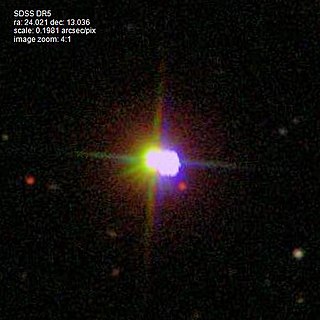
47 Aglaja is a large, dark main belt asteroid. It was discovered by Robert Luther on 15 September 1857 from Düsseldorf. The name was chosen by the Philosophical Faculty of the University of Bonn and refers to Aglaea, one of the Charites in Greek mythology. It was rendered Aglaia in English sources into the early 20th century, as 'i' and 'j' are equivalent in Latin names and in the Latin rendering of Greek names.

Pales is a large, dark main-belt asteroid. It was discovered by German-French astronomer Hermann Goldschmidt on 19 September 1857 from his balcony in Paris. The asteroid is named after Pales, the goddess of shepherds in Roman mythology. Since it was discovered on the same night as 48 Doris, geologist Élie de Beaumont suggested naming the two "The Twins".

Galatea is a large C-type main-belt asteroid. Its carbonaceous surface is very dark in color with an albedo of just 0.034. Galatea was found by the prolific comet discoverer Ernst Tempel on August 29, 1862, in Marseilles, France. It was his third asteroid discovery. It is named after one of the two Galateas in Greek mythology. A stellar occultation by Galatea was observed on September 8, 1987. The name Galatea has also been given to one of Neptune's satellites.

Dike is a quite large and dark main-belt asteroid. Dike was discovered by Alphonse Borrelly on May 28, 1868. It was his first asteroid discovery. This object is named after Dike, the Greek goddess of moral justice. Among the first hundred numbered minor planets, 99 Dike was considered anomalously faint for over a century. However, this was later found to be untrue.
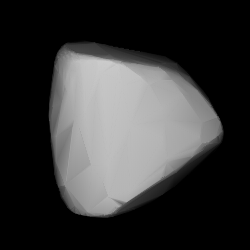
Hera is a moderately large main-belt asteroid with an orbital period of 4.44 years. It was discovered by Canadian-American astronomer James Craig Watson on September 7, 1868, and named after Hera, queen and fifth in power of the Olympian gods in Greek mythology. This is a stony S-type asteroid with a silicate surface composition.

Lachesis is a large main-belt asteroid. It was discovered by French astronomer Alphonse Borrelly on April 10, 1872, and independently by German-American astronomer Christian Heinrich Friedrich Peters on April 11, 1872, then named after Lachesis, one of the Moirai, or Fates, in Greek mythology. A Lachesean occultation of a star occurred in 1999 and was confirmed visually by five observers and once photoelectrically, with the chords yielding an estimated elliptical cross-section of 184 × 144 km.

Sophrosyne is a large main-belt asteroid that was discovered by German astronomer Robert Luther on 27 September 1873, and was named after the concept of sophrosyne, Plato's term for 'moderation'. Classified as a C-type asteroid, it has an exceedingly dark surface and most probably a primitive carbonaceous composition.
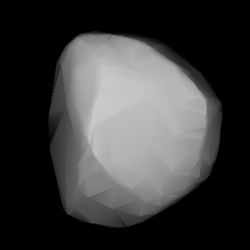
Nuwa is a large main-belt asteroid with an orbital period of 5.15 years. It was discovered by Canadian-American astronomer James Craig Watson on October 18, 1875, and named after Nüwa, the Chinese creator goddess. This object is a candidate member of the Hecuba group of asteroids that orbit near the 2:1 mean-motion resonance with Jupiter. Based upon the spectrum it is classified as a C-type asteroid, which indicates that it is probably composed of primitive carbonaceous chondritic material and the surface is exceedingly dark.

161 Athor is an M-type Main belt asteroid that was discovered by James Craig Watson on April 19, 1876, at the Detroit Observatory and named after Hathor, an Egyptian fertility goddess. It is the namesake of a proposed Athor asteroid family, estimated to be ~3 billion years old.

Prokne is a main-belt asteroid that was discovered by German-American astronomer C. H. F. Peters on March 21, 1879, in Clinton, New York, and named after Procne, the sister of Philomela in Greek mythology. Stellar occultations by Prokne have been observed twice, in 1984 from Italy and again in 1999 from Iowa.

Dynamene is a large dark main-belt asteroid that was discovered by German-American astronomer Christian Heinrich Friedrich Peters on July 27, 1879, in Clinton, New York. The name derives from Dynamene, one of the fifty Nereids in Greek mythology. Based upon its spectrum, 200 Dynamene is classified as a C-type asteroid, indicating that it probably has a primitive composition similar to the carbonaceous chondrite meteorites. The spectra of the asteroid displays evidence of aqueous alteration.
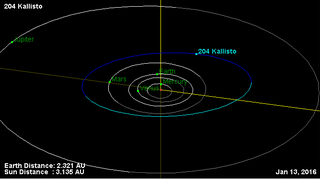
Kallisto is a fairly typical, although sizeable Main belt asteroid. It is classified as an S-type asteroid. Like other asteroids of its type, it is light in colour. It was discovered by Johann Palisa on 8 October 1879, in Pola, and was named after the same nymph Callisto in Greek mythology as Jupiter's moon Callisto.
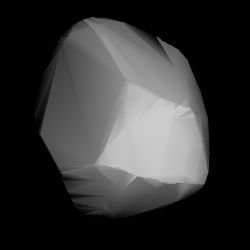
Eudora is a large Main belt asteroid. It was discovered by French (Corsican) astronomer J. Coggia on August 30, 1880, in Marseilles, France. It was his fourth asteroid discovery and is named after Eudora, a Hyad in Greek mythology.
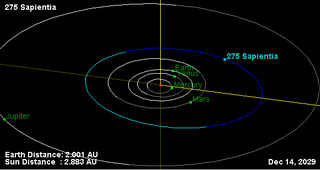
Sapientia is a very large Main belt asteroid that was discovered by Johann Palisa on 15 April 1888 in Vienna. It is classified as a C-type asteroid and is probably composed of carbonaceous material. It is named for the Roman personification of wisdom, Sapientia.

Regina is a typical, although fairly large, Main belt asteroid. It was discovered by Auguste Charlois on 3 August 1889 in Nice, France. The asteroid is a suspected interloper in the Eucharis asteroid family.
610 Valeska is a minor planet, specifically an asteroid, orbiting primarily in the asteroid belt. Discovered in 1906 by Max Wolf. The origin of the name is unknown, but it may be related to the provisional designation 1906 VK. In Slavic origin, it also means Glorious ruler. Photometric observations provide a rotation period of 4.9047±0.0002 h with a brightness variation of 0.17±0.03 in magnitude.
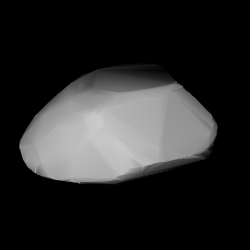
632 Pyrrha is a minor planet orbiting the Sun.
649 Josefa is a minor planet, specifically an asteroid, orbiting primarily in the asteroid belt. Photometric observations provide a rotation period of 10.481±0.001 h with a brightness variation of 0.33±0.04 in magnitude.
652 Jubilatrix is a minor planet, specifically an asteroid orbiting in the asteroid belt. It was discovered on 4 November 1907 by Austrian astronomer Johann Palisa, and was named in honor of the 60th anniversary of the reign of Franz Joseph. The asteroid is orbiting at a distance of 2.55 AU with a period of 4.08 yr and an eccentricity of 0.127. It is a member of the Maria dynamic family. Photometric observations provide a rotation period of 2.6627±0.0001 h with a brightness variation of 0.27±0.03 in magnitude.

694 Ekard is a minor planet orbiting the Sun that was discovered by American astronomer Joel Hastings Metcalf on November 7, 1909. The asteroid's name comes from the reverse spelling of Drake University in Des Moines, Iowa, where Seth Barnes Nicholson and his wife calculated its orbit.

















